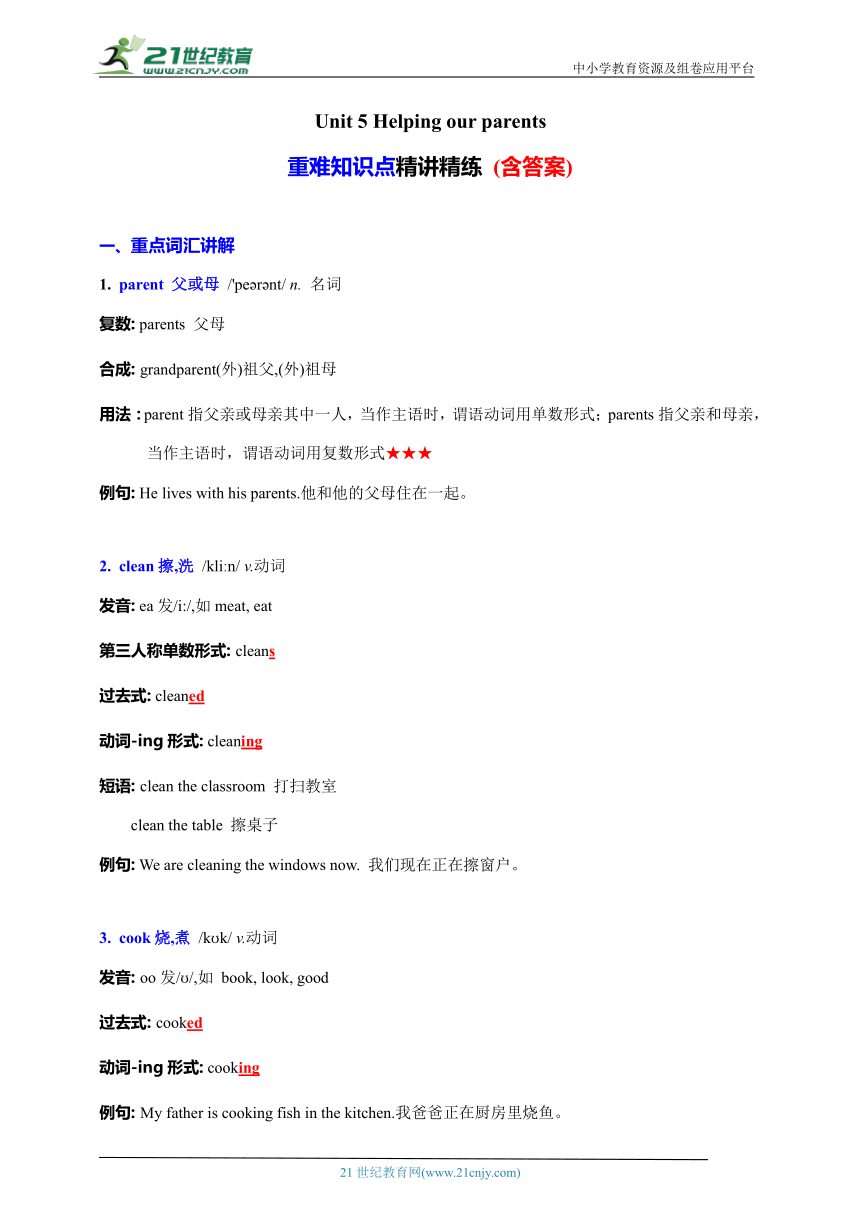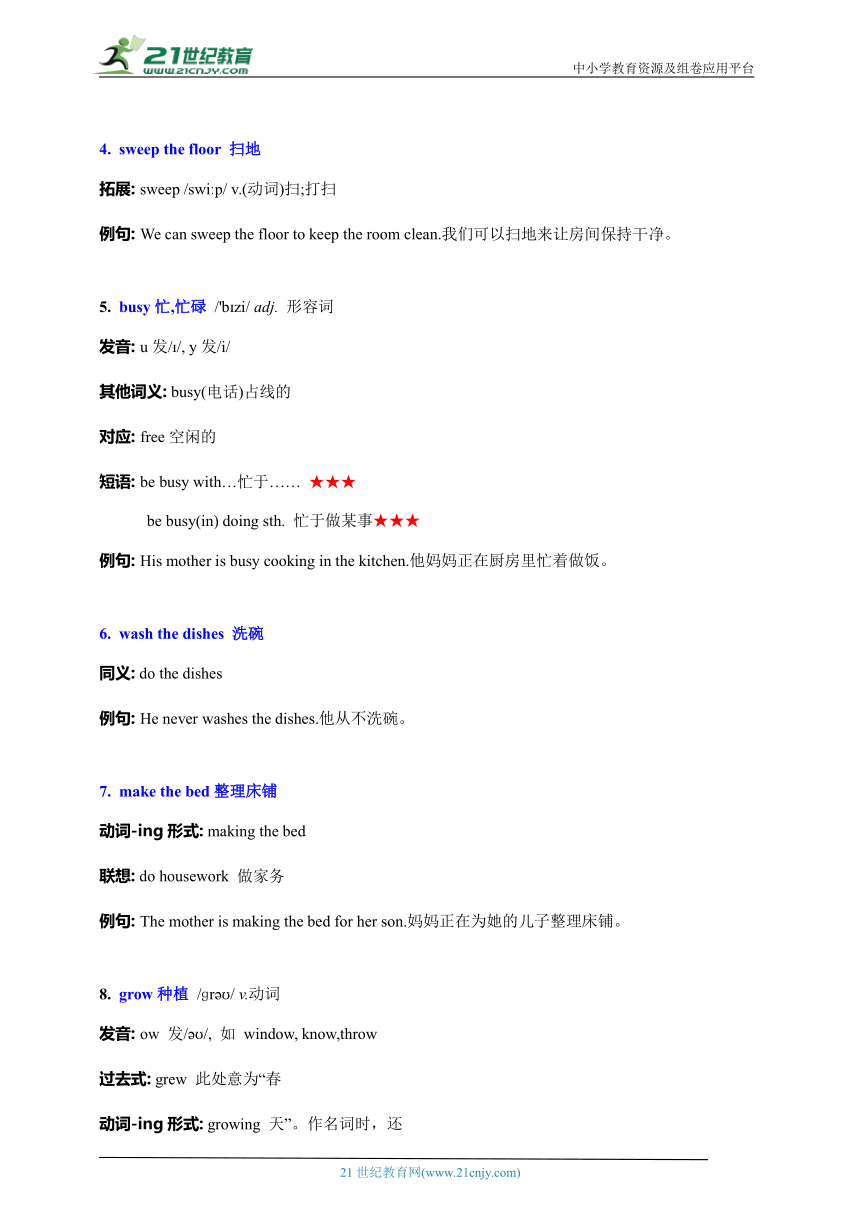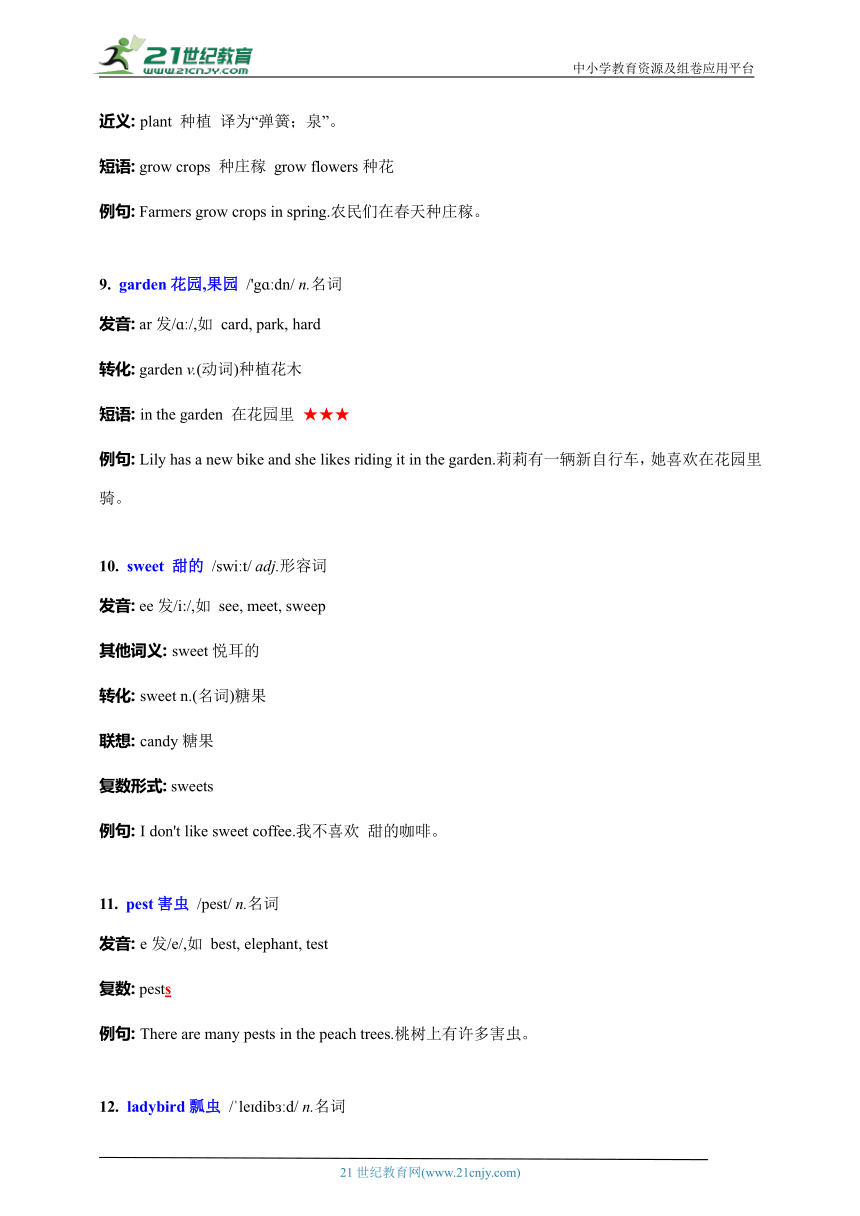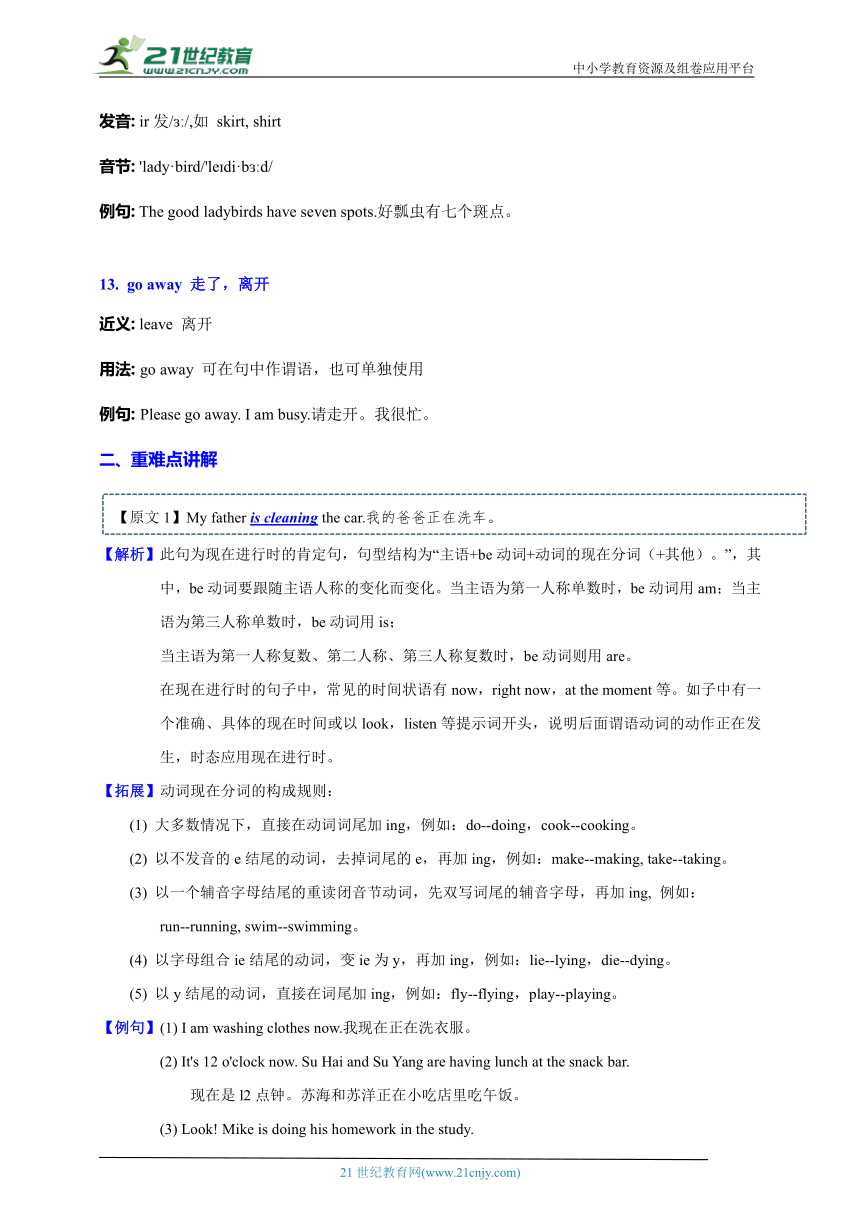Unit 5 Helping our parents 重难点精讲精练 (含答案)
文档属性
| 名称 | Unit 5 Helping our parents 重难点精讲精练 (含答案) |

|
|
| 格式 | docx | ||
| 文件大小 | 305.3KB | ||
| 资源类型 | 试卷 | ||
| 版本资源 | 牛津译林版 | ||
| 科目 | 英语 | ||
| 更新时间 | 2024-05-16 17:41:28 | ||
图片预览




文档简介
中小学教育资源及组卷应用平台
Unit 5 Helping our parents
重难知识点精讲精练 (含答案)
重点词汇讲解
parent 父或母 /'pe r nt/ n. 名词
复数: parents 父母
合成: grandparent(外)祖父,(外)祖母
用法:parent指父亲或母亲其中一人,当作主语时,谓语动词用单数形式;parents指父亲和母亲,当作主语时,谓语动词用复数形式★★★
例句: He lives with his parents.他和他的父母住在一起。
clean擦,洗 /kli n/ v.动词
发音: ea发/i:/,如meat, eat
第三人称单数形式: cleans
过去式: cleaned
动词-ing形式: cleaning
短语: clean the classroom 打扫教室
clean the table 擦桌子
例句: We are cleaning the windows now. 我们现在正在擦窗户。
cook烧,煮 /k k/ v.动词
发音: oo发/ /,如 book, look, good
过去式: cooked
动词-ing形式: cooking
例句: My father is cooking fish in the kitchen.我爸爸正在厨房里烧鱼。
sweep the floor 扫地
拓展: sweep /swi p/ v.(动词)扫;打扫
例句: We can sweep the floor to keep the room clean.我们可以扫地来让房间保持干净。
busy忙,忙碌 /'b zi/ adj. 形容词
发音: u发/ /, y发/i/
其他词义: busy(电话)占线的
对应: free空闲的
短语: be busy with…忙于…… ★★★
be busy(in) doing sth. 忙于做某事★★★
例句: His mother is busy cooking in the kitchen.他妈妈正在厨房里忙着做饭。
wash the dishes 洗碗
同义: do the dishes
例句: He never washes the dishes.他从不洗碗。
make the bed整理床铺
动词-ing形式: making the bed
联想: do housework 做家务
例句: The mother is making the bed for her son.妈妈正在为她的儿子整理床铺。
grow种植 /ɡr / v.动词
发音: ow 发/ /, 如 window, know,throw
过去式: grew 此处意为“春
动词-ing形式: growing 天”。作名词时,还
近义: plant 种植 译为“弹簧;泉”。
短语: grow crops 种庄稼 grow flowers种花
例句: Farmers grow crops in spring.农民们在春天种庄稼。
garden花园,果园 /'gɑ dn/ n.名词
发音: ar发/ɑ /,如 card, park, hard
转化: garden v.(动词)种植花木
短语: in the garden 在花园里 ★★★
例句: Lily has a new bike and she likes riding it in the garden.莉莉有一辆新自行车,她喜欢在花园里骑。
sweet 甜的 /swi t/ adj.形容词
发音: ee发/i:/,如 see, meet, sweep
其他词义: sweet悦耳的
转化: sweet n.(名词)糖果
联想: candy糖果
复数形式: sweets
例句: I don't like sweet coffee.我不喜欢 甜的咖啡。
pest害虫 /pest/ n.名词
发音: e发/e/,如 best, elephant, test
复数: pests
例句: There are many pests in the peach trees.桃树上有许多害虫。
ladybird瓢虫 / le dib d/ n.名词
发音: ir发/ /,如 skirt, shirt
音节: 'lady·bird/'le di·b d/
例句: The good ladybirds have seven spots.好瓢虫有七个斑点。
go away 走了,离开
近义: leave 离开
用法: go away 可在句中作谓语,也可单独使用
例句: Please go away. I am busy.请走开。我很忙。
重难点讲解
【解析】此句为现在进行时的肯定句,句型结构为“主语+be动词+动词的现在分词(+其他)。”,其中,be动词要跟随主语人称的变化而变化。当主语为第一人称单数时,be动词用am;当主语为第三人称单数时,be动词用is;
当主语为第一人称复数、第二人称、第三人称复数时,be动词则用are。
在现在进行时的句子中,常见的时间状语有now,right now,at the moment等。如子中有一个准确、具体的现在时间或以look,listen等提示词开头,说明后面谓语动词的动作正在发生,时态应用现在进行时。
【拓展】动词现在分词的构成规则:
大多数情况下,直接在动词词尾加ing,例如:do--doing,cook--cooking。
以不发音的e结尾的动词,去掉词尾的e,再加ing,例如:make--making, take--taking。
以一个辅音字母结尾的重读闭音节动词,先双写词尾的辅音字母,再加ing, 例如:
run--running, swim--swimming。
以字母组合ie结尾的动词,变ie为y,再加ing,例如:lie--lying,die--dying。
以y结尾的动词,直接在词尾加ing,例如:fly--flying,play--playing。
【例句】(1) I am washing clothes now.我现在正在洗衣服。
(2) It's 12 o'clock now. Su Hai and Su Yang are having lunch at the snack bar.
现在是l2点钟。苏海和苏洋正在小吃店里吃午饭。
(3) Look! Mike is doing his homework in the study.
看!迈克正在书房里做他的家庭作业。
【练习】(1) 根据中文提示完成句子。
李老师正在阅览室里看书。
Miss Li in the reading room.
(2)改错。
( )Listen! The girls sing in the music room.
A B C
【答案】(1)is reading books (2)C are singing
【解析】问句是由what引导的现在进行时的特殊疑问句
句型结构为“What+be动词+主语+doing(+其他)?”,用来询问别人正在做什么,回答时用“主语十be动词十动词的现在分词(+其他)。”。
【例句】--What are you doing at the moment 你此刻正在做什么?
--I'm making a cake.我正在做一个蛋糕。
【练习】(1)按要求完成句子。
Mike and Helen are watching TV in the bedroom.(对画线部分提问)
Mike and Helen in the bedroom
(2)根据中文提示完成对话。
--猫基蒂正在做什么? --她正在和一只玩具老鼠玩。
-- the cat Kitty
-- with a toy mouse.
【答案】(1)What are,doing (2)What is,doing,She's playing
【解析】此句中的the dog为Ben的同位语。同位语一般紧跟其所要修饰的单词(短语),起限定或说明的作用。当同位语与所修饰的单词(短语)关系紧密时,两者之间不用逗号隔开。当同位语对其所修饰的单词(短语)只作补充解释时,两者之间可用逗号隔开。注意,含有同位语的句子中的谓语动词的形式取决于主语的单复数,而不是取决于同位语。
【例句】(l)Your brother James is eating my hamburger.
你的弟弟詹姆斯正在吃我的汉堡包。
(2)Mr White,our new teacher,is very nice to us.
怀特先生,我们的新老师,对我们很友好。
【练习】单项选择。
( )Mrs Wang, the children's teacher, in the office.
A.is checking the homework B.are checking the homework
C.check the homework
【答案】A
【解析】此句中的busy为形容词,意为“忙,忙碌”。它在句子中既可以作定语,用于名词前,也可以作表语,常与be动词搭配使用。表示“忙于做某事”可以用be busy with sth/(in)doing sth。
【例句】(1)My grandmother is busy with the housework all day.
我的祖母整天忙于家务。
(2)They are busy(in)cleaning the classroom.他们忙于打扫教室。
【练习】单项选择。
( )Mr Wang is still busy his work at night.
A.in B.on C.with
【答案】C
【解析】动词like后既可以接to do sth,也可以接doing sth,两者都译为“喜欢做某事”,但区别在于,like to do sth表示临时性的动作,强调具体的某一次行为,而like doing sth表示某人的爱好或经常性的动作。
watch.doing sth意为“看见…正在做某事”,强调看见正在做某事,
而watch.do sth意为“看见…做某事”,强调看见做某事的整个过程。
【例句】(l) My father likes swimming,but he doesn't like to swim today.
我的父亲喜欢游泳,但是今天他不想游泳。
(2)I watch the girl helping others.。我看见那个女孩正在帮助别人。
(3)We can watch the birds fly in the sky.我们能看见鸟在天空中飞期。
【练习】根据中文提示完成句子。
在晚上,我喜欢坐着听风吹过的声音。
In the evening, I like and the wind blowing.
【答案】to sit, listen to
【解析】此句中的第二个分句为省略句,共完整表达为“but the ladybirds do not go away”。在英语中,为了避免重复而省去句子中的某些部分,这种现象叫作省略。
【例句】(1) He likes playing computer games,but his sister doesn't.
他喜欢玩电脑游戏,但是他的姐姐不喜欢。
(2)I'm good at drawing,but they are not. 我擅长画画,但是他们不擅长。
【练习】单项选择。
( )Mike often goes fishing with his father,but today he
A.isn't B.doesn't C.aren't
【答案】B
第二部分:易错易混全解
易混淆动词wash与clean的用法
【例题】从方框中选择合适的单词,并用其适当的形式填空。
clean wash
Nancy sometimes the dishes after dinner.
Paul and Daniel are the windows in the classroom.
【答案】(1)washes (2)cleaning
点拨: wash和clean都有“洗”的意思,两者的区别在于,wash通常指用水、洗涤剂、肥皂等洗掉物品或身体某部位的污物;clean则主要强调除去物体表面的灰尘,并不注重采用哪种清洁方式。题(1),所要清洗的对象dishes需要浸泡在水中或用清洁剂清洗,所以动词用wash,且句子的主语为第三人称单数Nancy,故填washes。题(2),擦窗户通常指去除窗户上的灰尘,所以动词用clean,因设空处前有be动词are,故填clean的现在分词cleaning。
易混淆动词grow与plant的用法
【例题】选词填空。
The farmers (grow/plant) wheat(小麦) and rice every year.
(2)The children will (grow/plant) some trees this Tree Planting Day.
【答案】(1)grow (2)plant
点拨: grow和plant都可以译为“种植”,两者的区别在于,grow着重指种植之后的栽培、管理的过程,而plant则着重指“种植”这一行为。题(1),小麦和大米在种植后需要精心的管理和照顾,故填grow。题(2),在植树节种树主要强调“种树”这一行为,故填plant。
21世纪教育网 www.21cnjy.com 精品试卷·第 2 页 (共 2 页)
21世纪教育网(www.21cnjy.com)
Unit 5 Helping our parents
重难知识点精讲精练 (含答案)
重点词汇讲解
parent 父或母 /'pe r nt/ n. 名词
复数: parents 父母
合成: grandparent(外)祖父,(外)祖母
用法:parent指父亲或母亲其中一人,当作主语时,谓语动词用单数形式;parents指父亲和母亲,当作主语时,谓语动词用复数形式★★★
例句: He lives with his parents.他和他的父母住在一起。
clean擦,洗 /kli n/ v.动词
发音: ea发/i:/,如meat, eat
第三人称单数形式: cleans
过去式: cleaned
动词-ing形式: cleaning
短语: clean the classroom 打扫教室
clean the table 擦桌子
例句: We are cleaning the windows now. 我们现在正在擦窗户。
cook烧,煮 /k k/ v.动词
发音: oo发/ /,如 book, look, good
过去式: cooked
动词-ing形式: cooking
例句: My father is cooking fish in the kitchen.我爸爸正在厨房里烧鱼。
sweep the floor 扫地
拓展: sweep /swi p/ v.(动词)扫;打扫
例句: We can sweep the floor to keep the room clean.我们可以扫地来让房间保持干净。
busy忙,忙碌 /'b zi/ adj. 形容词
发音: u发/ /, y发/i/
其他词义: busy(电话)占线的
对应: free空闲的
短语: be busy with…忙于…… ★★★
be busy(in) doing sth. 忙于做某事★★★
例句: His mother is busy cooking in the kitchen.他妈妈正在厨房里忙着做饭。
wash the dishes 洗碗
同义: do the dishes
例句: He never washes the dishes.他从不洗碗。
make the bed整理床铺
动词-ing形式: making the bed
联想: do housework 做家务
例句: The mother is making the bed for her son.妈妈正在为她的儿子整理床铺。
grow种植 /ɡr / v.动词
发音: ow 发/ /, 如 window, know,throw
过去式: grew 此处意为“春
动词-ing形式: growing 天”。作名词时,还
近义: plant 种植 译为“弹簧;泉”。
短语: grow crops 种庄稼 grow flowers种花
例句: Farmers grow crops in spring.农民们在春天种庄稼。
garden花园,果园 /'gɑ dn/ n.名词
发音: ar发/ɑ /,如 card, park, hard
转化: garden v.(动词)种植花木
短语: in the garden 在花园里 ★★★
例句: Lily has a new bike and she likes riding it in the garden.莉莉有一辆新自行车,她喜欢在花园里骑。
sweet 甜的 /swi t/ adj.形容词
发音: ee发/i:/,如 see, meet, sweep
其他词义: sweet悦耳的
转化: sweet n.(名词)糖果
联想: candy糖果
复数形式: sweets
例句: I don't like sweet coffee.我不喜欢 甜的咖啡。
pest害虫 /pest/ n.名词
发音: e发/e/,如 best, elephant, test
复数: pests
例句: There are many pests in the peach trees.桃树上有许多害虫。
ladybird瓢虫 / le dib d/ n.名词
发音: ir发/ /,如 skirt, shirt
音节: 'lady·bird/'le di·b d/
例句: The good ladybirds have seven spots.好瓢虫有七个斑点。
go away 走了,离开
近义: leave 离开
用法: go away 可在句中作谓语,也可单独使用
例句: Please go away. I am busy.请走开。我很忙。
重难点讲解
【解析】此句为现在进行时的肯定句,句型结构为“主语+be动词+动词的现在分词(+其他)。”,其中,be动词要跟随主语人称的变化而变化。当主语为第一人称单数时,be动词用am;当主语为第三人称单数时,be动词用is;
当主语为第一人称复数、第二人称、第三人称复数时,be动词则用are。
在现在进行时的句子中,常见的时间状语有now,right now,at the moment等。如子中有一个准确、具体的现在时间或以look,listen等提示词开头,说明后面谓语动词的动作正在发生,时态应用现在进行时。
【拓展】动词现在分词的构成规则:
大多数情况下,直接在动词词尾加ing,例如:do--doing,cook--cooking。
以不发音的e结尾的动词,去掉词尾的e,再加ing,例如:make--making, take--taking。
以一个辅音字母结尾的重读闭音节动词,先双写词尾的辅音字母,再加ing, 例如:
run--running, swim--swimming。
以字母组合ie结尾的动词,变ie为y,再加ing,例如:lie--lying,die--dying。
以y结尾的动词,直接在词尾加ing,例如:fly--flying,play--playing。
【例句】(1) I am washing clothes now.我现在正在洗衣服。
(2) It's 12 o'clock now. Su Hai and Su Yang are having lunch at the snack bar.
现在是l2点钟。苏海和苏洋正在小吃店里吃午饭。
(3) Look! Mike is doing his homework in the study.
看!迈克正在书房里做他的家庭作业。
【练习】(1) 根据中文提示完成句子。
李老师正在阅览室里看书。
Miss Li in the reading room.
(2)改错。
( )Listen! The girls sing in the music room.
A B C
【答案】(1)is reading books (2)C are singing
【解析】问句是由what引导的现在进行时的特殊疑问句
句型结构为“What+be动词+主语+doing(+其他)?”,用来询问别人正在做什么,回答时用“主语十be动词十动词的现在分词(+其他)。”。
【例句】--What are you doing at the moment 你此刻正在做什么?
--I'm making a cake.我正在做一个蛋糕。
【练习】(1)按要求完成句子。
Mike and Helen are watching TV in the bedroom.(对画线部分提问)
Mike and Helen in the bedroom
(2)根据中文提示完成对话。
--猫基蒂正在做什么? --她正在和一只玩具老鼠玩。
-- the cat Kitty
-- with a toy mouse.
【答案】(1)What are,doing (2)What is,doing,She's playing
【解析】此句中的the dog为Ben的同位语。同位语一般紧跟其所要修饰的单词(短语),起限定或说明的作用。当同位语与所修饰的单词(短语)关系紧密时,两者之间不用逗号隔开。当同位语对其所修饰的单词(短语)只作补充解释时,两者之间可用逗号隔开。注意,含有同位语的句子中的谓语动词的形式取决于主语的单复数,而不是取决于同位语。
【例句】(l)Your brother James is eating my hamburger.
你的弟弟詹姆斯正在吃我的汉堡包。
(2)Mr White,our new teacher,is very nice to us.
怀特先生,我们的新老师,对我们很友好。
【练习】单项选择。
( )Mrs Wang, the children's teacher, in the office.
A.is checking the homework B.are checking the homework
C.check the homework
【答案】A
【解析】此句中的busy为形容词,意为“忙,忙碌”。它在句子中既可以作定语,用于名词前,也可以作表语,常与be动词搭配使用。表示“忙于做某事”可以用be busy with sth/(in)doing sth。
【例句】(1)My grandmother is busy with the housework all day.
我的祖母整天忙于家务。
(2)They are busy(in)cleaning the classroom.他们忙于打扫教室。
【练习】单项选择。
( )Mr Wang is still busy his work at night.
A.in B.on C.with
【答案】C
【解析】动词like后既可以接to do sth,也可以接doing sth,两者都译为“喜欢做某事”,但区别在于,like to do sth表示临时性的动作,强调具体的某一次行为,而like doing sth表示某人的爱好或经常性的动作。
watch.doing sth意为“看见…正在做某事”,强调看见正在做某事,
而watch.do sth意为“看见…做某事”,强调看见做某事的整个过程。
【例句】(l) My father likes swimming,but he doesn't like to swim today.
我的父亲喜欢游泳,但是今天他不想游泳。
(2)I watch the girl helping others.。我看见那个女孩正在帮助别人。
(3)We can watch the birds fly in the sky.我们能看见鸟在天空中飞期。
【练习】根据中文提示完成句子。
在晚上,我喜欢坐着听风吹过的声音。
In the evening, I like and the wind blowing.
【答案】to sit, listen to
【解析】此句中的第二个分句为省略句,共完整表达为“but the ladybirds do not go away”。在英语中,为了避免重复而省去句子中的某些部分,这种现象叫作省略。
【例句】(1) He likes playing computer games,but his sister doesn't.
他喜欢玩电脑游戏,但是他的姐姐不喜欢。
(2)I'm good at drawing,but they are not. 我擅长画画,但是他们不擅长。
【练习】单项选择。
( )Mike often goes fishing with his father,but today he
A.isn't B.doesn't C.aren't
【答案】B
第二部分:易错易混全解
易混淆动词wash与clean的用法
【例题】从方框中选择合适的单词,并用其适当的形式填空。
clean wash
Nancy sometimes the dishes after dinner.
Paul and Daniel are the windows in the classroom.
【答案】(1)washes (2)cleaning
点拨: wash和clean都有“洗”的意思,两者的区别在于,wash通常指用水、洗涤剂、肥皂等洗掉物品或身体某部位的污物;clean则主要强调除去物体表面的灰尘,并不注重采用哪种清洁方式。题(1),所要清洗的对象dishes需要浸泡在水中或用清洁剂清洗,所以动词用wash,且句子的主语为第三人称单数Nancy,故填washes。题(2),擦窗户通常指去除窗户上的灰尘,所以动词用clean,因设空处前有be动词are,故填clean的现在分词cleaning。
易混淆动词grow与plant的用法
【例题】选词填空。
The farmers (grow/plant) wheat(小麦) and rice every year.
(2)The children will (grow/plant) some trees this Tree Planting Day.
【答案】(1)grow (2)plant
点拨: grow和plant都可以译为“种植”,两者的区别在于,grow着重指种植之后的栽培、管理的过程,而plant则着重指“种植”这一行为。题(1),小麦和大米在种植后需要精心的管理和照顾,故填grow。题(2),在植树节种树主要强调“种树”这一行为,故填plant。
21世纪教育网 www.21cnjy.com 精品试卷·第 2 页 (共 2 页)
21世纪教育网(www.21cnjy.com)
